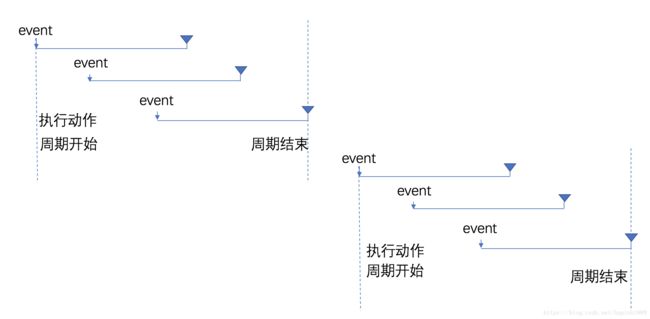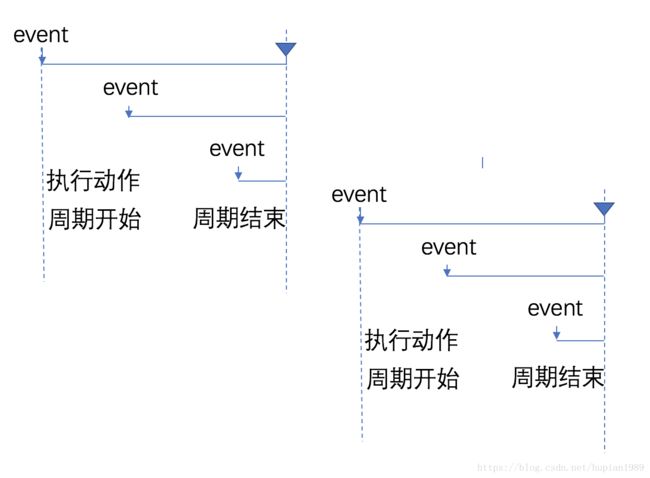防抖(debounce) 和 节流(throttling)
防抖和节流是针对响应跟不上触发频率这类问题的两种解决方案。 在给DOM绑定事件时,有些事件我们是无法控制触发频率的。 如鼠标移动事件onmousemove, 滚动滚动条事件onscroll,窗口大小改变事件onresize,瞬间的操作都会导致这些事件会被高频触发。 如果事件的回调函数较为复杂,就会导致响应跟不上触发,出现页面卡顿,假死现象。 在实时检查输入时,如果我们绑定onkeyup事件发请求去服务端检查,用户输入过程中,事件的触发频率也会很高,会导致大量的请求发出,响应速度会大大跟不上触发。
针对此类快速连续触发和不可控的高频触发问题,debounce 和 throttling 给出了两种解决策略;
debounce,去抖动。策略是当事件被触发时,设定一个周期延迟执行动作,若期间又被触发,则重新设定周期,直到周期结束,执行动作。 这是debounce的基本思想,在后期又扩展了前缘debounce,即执行动作在前,然后设定周期,周期内有事件被触发,不执行动作,且周期重新设定。
延迟debounce,示意图:
前缘debounce, 示意图
debounce的特点是当事件快速连续不断触发时,动作只会执行一次。 延迟debounce,是在周期结束时执行,前缘debounce,是在周期开始时执行。但当触发有间断,且间断大于我们设定的时间间隔时,动作就会有多次执行。
debounce 的实现:
版本1: 周期内有新事件触发,清除旧定时器,重置新定时器;这种方法,需要高频的创建定时器。
// 暴力版: 定时器期间,有新操作时,清空旧定时器,重设新定时器
var debounce = (fn, wait) => {
let timer, timeStamp=0;
let context, args;
let run = ()=>{
timer= setTimeout(()=>{
fn.apply(context,args);
},wait);
}
let clean = () => {
clearTimeout(timer);
}
return function(){
context=this;
args=arguments;
let now = (new Date()).getTime();
if(now-timeStamp < wait){
console.log('reset',now);
clean(); // clear running timer
run(); // reset new timer from current time
}else{
console.log('set',now);
run(); // last timer alreay executed, set a new timer
}
timeStamp=now;
}
}版本2: 周期内有新事件触发时,重置定时器开始时间撮,定时器执行时,判断开始时间撮,若开始时间撮被推后,重新设定延时定时器。
/ 优化版: 定时器执行时,判断start time 是否向后推迟了,若是,设置延迟定时器
var debounce = (fn, wait) => {
let timer, startTimeStamp=0;
let context, args;
let run = (timerInterval)=>{
timer= setTimeout(()=>{
let now = (new Date()).getTime();
let interval=now-startTimeStamp
if(interval版本3: 在版本2基础上增加是否立即执行选项:
// 增加前缘触发功能
var debounce = (fn, wait, immediate=false) => {
let timer, startTimeStamp=0;
let context, args;
let run = (timerInterval)=>{
timer= setTimeout(()=>{
let now = (new Date()).getTime();
let interval=now-startTimeStamp
if(interval
throttling,节流的策略是,固定周期内,只执行一次动作,若有新事件触发,不执行。周期结束后,又有事件触发,开始新的周期。 节流策略也分前缘和延迟两种。与debounce类似,延迟是指 周期结束后执行动作,前缘是指执行动作后再开始周期。
延迟throttling示意图:
前缘throttling 示意图:
throttling的特点在连续高频触发事件时,动作会被定期执行,响应平滑。
throttling 的实现:
版本1: 简单版
简单版: 定时器期间,只执行最后一次操作
var throttling = (fn, wait) => {
let timer;
let context, args;
let run = () => {
timer=setTimeout(()=>{
fn.apply(context,args);
clearTimeout(timer);
timer=null;
},wait);
}
return function () {
context=this;
args=arguments;
if(!timer){
console.log("throttle, set");
run();
}else{
console.log("throttle, ignore");
}
}
}版本2: 增加前缘选项:(考虑情况较简单,复杂情况可参考underscope 的_.throttle)
/// 增加前缘
var throttling = (fn, wait, immediate) => {
let timer, timeStamp=0;
let context, args;
let run = () => {
timer=setTimeout(()=>{
if(!immediate){
fn.apply(context,args);
}
clearTimeout(timer);
timer=null;
},wait);
}
return function () {
context=this;
args=arguments;
if(!timer){
console.log("throttle, set");
if(immediate){
fn.apply(context,args);
}
run();
}else{
console.log("throttle, ignore");
}
}
}
debounce和throttling 各有特点,在不同 的场景要根据需求合理的选择策略。如果事件触发是高频但是有停顿时,可以选择debounce; 在事件连续不断高频触发时,只能选择throttling,因为debounce可能会导致动作只被执行一次,界面出现跳跃。



